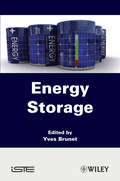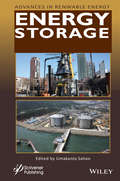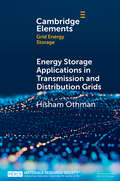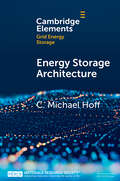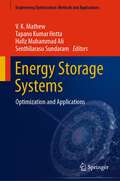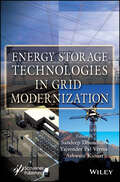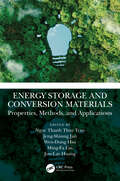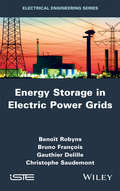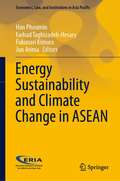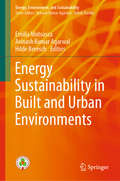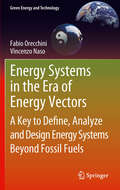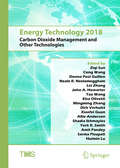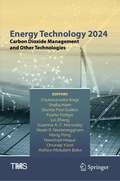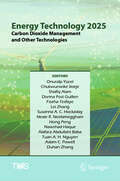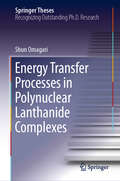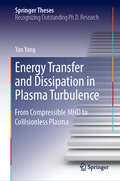- Table View
- List View
Energy Storage
by Yves BrunetEnergy storage examines different applications such as electric power generation, transmission and distribution systems, pulsed systems, transportation, buildings and mobile applications. For each of these applications, proper energy storage technologies are foreseen, with their advantages, disadvantages and limits. As electricity cannot be stored cheaply in large quantities, energy has to be stored in another form (chemical, thermal, electromagnetic, mechanical) and then converted back into electric power and/or energy using conversion systems. Most of the storage technologies are examined: batteries, hydrogen, super capacitors, SMES, flywheels, CAES, thermal storage and hydraulic gravitational storage.
Energy Storage (Advances In Renewable Energy Ser.)
by Umakanta SahooThe world’s energy landscape is very complex. Fossil fuels, especially because of hydraulic fracturing, are still a mainstay of global energy production, but renewable energy sources, such as wind, solar, and others, are increasing in importance for global energy sustainability. Experts and non-experts agree that the next game-changer in this area will be energy storage. Energy storage is crucial for continuous operation of power plants and can supplement basic power generation sources over a stand-alone system. It can enhance capacity and leads to greater security, including continuous electricity supply and other applications. A dependable energy storage system not only guarantees that the grid will not go down, but also increases efficacy and efficiency of any energy system. This groundbreaking new volume in this forward thinking series addresses all of these issues, laying out the latest advances and addressing the most serious current concerns in energy storage. Whether for the veteran engineer or the student, this latest volume in the series, “Advances in Renewable Energy,” is a must-have for any library.
Energy Storage Applications in Transmission and Distribution Grids (Elements in Grid Energy Storage)
by Hisham OthmanThe application of energy storage within transmission and distribution grids as non-wire alternative solutions (NWS) is hindered by the lack of readily available analysis tools, standardized planning processes, and practical know-how. This Element provides a theoretical basis along with examples and real-world case studies to guide grid planners in the siting, sizing, and lifetime techno-economic evaluation of storage systems. Many applications are illustrated including feeder peak shaving, feeder reliability improvements, transmission reliability, transmission congestion relief, and renewable integration. Three case studies, based on the author's consulting experience, illustrate the versatility of the analysis methods and provide a guide to grid planners while tackling real world problems.
Energy Storage Architecture (Elements in Grid Energy Storage)
by C. Michael HoffEnergy storage systems (ESS) exist in a wide variety of sizes, shapes and technologies. An energy storage system's technology, i.e. the fundamental energy storage mechanism, naturally affects its important characteristics including cost, safety, performance, reliability, and longevity. However, while the underlying technology is important, a successful energy storage project relies on a thorough and thoughtful implementation of the technology to meet the project's goals. A successful implementation depends on how well the energy storage system is architected and assembled. The system's architecture can determine its performance and reliability, in concert with or even despite the technology it employs. It is possible for an energy storage system with a good storage technology to perform poorly when implemented with a suboptimal architecture, while other energy storage systems with mediocre storage technologies can perform well when implemented with superior architectures.
Energy Storage Systems: Optimization and Applications (Engineering Optimization: Methods and Applications)
by Hafiz Muhammad Ali Tapano Kumar Hotta V. K. Mathew Senthilarasu SundaramThis book discusses generalized applications of energy storage systems using experimental, numerical, analytical, and optimization approaches. The book includes novel and hybrid optimization techniques developed for energy storage systems. It provides a range of applications of energy storage systems on a single platform. The book broadly covers—thermal management of electronic components in portable electronic devices; modeling and optimization aspects of energy storage systems; management of power generation systems involving renewable energy; testing, evaluation, and life cycle assessment of energy storage systems, etc. This book will serve as a reference resource for researchers and practitioners in academia and industry.
Energy Storage Technologies in Grid Modernization
by Ashwani Kumar Sandeep Dhundhara Yajvender Pal VermaENERGY STORAGE TECHNOLOGIES IN GRID MODERNIZATION Written and edited by a team of experts, this exciting new volume discusses the various types of energy storage technologies, the applications of energy storage systems, their role in the real-time operation of power markets, and the operational issues of modern power systems, including renewable-based generating sources. The worldwide energy sector, specifically power generation, has undergone a huge transformation in recent years, and the focus is to make it sustainable, environmentally friendly, reliable, and highly efficient. As a result, a significant share of highly intermittent but clean renewable sources is being integrated into the power system using advanced technological components. The higher penetration level of renewable energy sources (RESs) has increased the active power generation share in the grid but reduced the total rotating system inertia. This high reduction in inertia brings new challenges and technical issues to the operators of modern power systems and impacts the stability and security of the grid. The stochasticity of these renewable sources also poses a big challenge to the efficient operation of the power system. Electrical energy storage systems help to manage such issues and challenges that occur due to the intermittent nature of RES and can play a big role in the smooth and reliable operation of the power system. The applications and opportunities to use storage on the grid are growing due to the improvements in energy storage technologies, and flexible regulatory frameworks. Technological developments have made it possible to use batteries and other Energy Storage Systems (ESSs) for managing the operation of the power system. This book aims to illustrate the potential of energy storage systems in different applications of the modern power system considering recent advances and research trends in storage technologies. These areas are going to play a very significant role in future smart grid operations. This book discusses the various types of energy storage technologies and promotes the applications of ESSs in the performance improvement of modern power systems. Whether for the veteran engineer, new hire, or student, it is a must-have for any library.
Energy Storage and Conversion Devices: Supercapacitors, Batteries, and Hydroelectric Cells (Emerging Materials and Technologies)
by Anurag GaurThis book presents a state-of-the-art overview of the research and development in designing electrode and electrolyte materials for Li-ion batteries and supercapacitors. Further, green energy production via the water splitting approach by the hydroelectric cell is also explored. Features include: • Provides details on the latest trends in design and optimization of electrode and electrolyte materials with key focus on enhancement of energy storage and conversion device performance • Focuses on existing nanostructured electrodes and polymer electrolytes for device fabrication, as well as new promising research routes toward the development of new materials for improving device performance • Features a dedicated chapter that explores electricity generation by dissociating water through hydroelectric cells, which are a nontoxic and green source of energy production • Describes challenges and offers a vision for next-generation devices This book is beneficial for advanced students and professionals working in energy storage across the disciplines of physics, materials science, chemistry, and chemical engineering. It is also a valuable reference for manufacturers of electrode/electrolyte materials for energy storage devices and hydroelectric cells.
Energy Storage and Conversion Materials: Properties, Methods, and Applications
by Ming-Fa Lin Wen-Dung Hsu Jow-Lay Huang Jeng-Shiung Jan Tran, Ngoc Thanh ThuyThis book explores the fundamental properties of a wide range of energy storage and conversion materials, covering mainstream theoretical and experimental studies and their applications in green energy. It presents a thorough investigation of diverse physical, chemical, and material properties of rechargeable batteries, supercapacitors, solar cells, and fuel cells, covering the development of theoretical simulations, machine learning, high-resolution experimental measurements, and excellent device performance. Covers potential energy storage (rechargeable batteries and supercapacitors) and energy conversion (solar cells and fuel cells) materials Develops theoretical predictions and experimental observations under a unified quasi-particle framework Illustrates up-to-date calculation results and experimental measurements Describes successful synthesis, fabrication, and measurements, as well as potential applications and near-future challenges Promoting a deep understanding of basic science, application engineering, and commercial products, this work is appropriate for senior graduate students and researchers in materials, chemical, and energy engineering and related disciplines.
Energy Storage in Electric Power Grids
by Benoît Robyns Bruno François Christophe Saudemont Gauthier DelilleThis book deals with the management and valuation of energy storage in electric power grids, highlighting the interest of storage systems in grid applications and developing management methodologies based on artificial intelligence tools. The authors highlight the importance of storing electrical energy, in the context of sustainable development, in "smart grids", and discuss multiple services that storing electrical energy can bring. Methodological tools are provided to build an energy management system storage following a generic approach. These tools are based on causal formalisms, artificial intelligence and explicit optimization techniques and are presented throughout the book in connection with concrete case studies.
Energy Storage: Hybridization of Power-to-Gas Technology and Carbon Capture (Springerbriefs In Energy Ser.)
by Manuel Bailera Pilar Lisbona Begoña Peña Luis M. RomeoThis book presents a detailed analysis of Power-to-Gas, a promising energy storage technology. It discusses the main mechanisms involved, and presents two Power-to-Gas and carbon capture hybridizations. The book begins by providing an introduction to energy storage technologies. It then reviews a number of Power-to-Gas projects now in progress, highlighting the current barriers to commercializing the technology. Moreover, the book presents two novel Power-to-Gas hybridizations, which improve the technology’s applicability in terms of efficiency, utilization of resources and profitability. Given its scope, the book will be of interest to graduate students, researchers and practitioners in the fields of engineering and energy.
Energy Sustainability and Climate Change in ASEAN (Economics, Law, and Institutions in Asia Pacific)
by Farhad Taghizadeh-Hesary Fukunari Kimura Han Phoumin Jun ArimaThis book provides several up-to-date empirical policy-oriented studies on assessing the impacts of climate change on various economic sectors and the role of renewable energy resources in mitigating pollution and climate change. It suggests various policy recommendations on how to increase the share of renewable energy resources in the energy baskets of the members of the Association of Southeast Asian Nations (ASEAN) and the rest of the world to ensure energy sustainability. As of 2020, most of the world’s energy investment still went to carbon-emitting sources, namely, fossil fuels. On the other hand, the Covid-19 pandemic and the economic Project Overview 20 March 2021 08:39 Page 6 of 9 downturns shrank the global energy demand, including fossil fuels, resulting in a sharp drop in their prices. Low fossil fuel prices are harmful to developing renewable energy projects, making solar, wind, and other renewable energy resources less competitive as sources of electricity. This is endangering the Paris agreement and the “Climate Action” goal of the United Nations. Given the high share of fossil fuels in the energy mix of the members of ASEAN, tremendous challenges must be faced for their energy transition in the post-Covid-19 world. The authors call for sound policy and applicable technologies to ensure sustainable energy availability, accessibility, and affordability to reach emission reduction targets.
Energy Sustainability in Built and Urban Environments (Energy, Environment, and Sustainability)
by Avinash Kumar Agarwal Emilia Motoasca Hilde BreeschThis book covers different aspects of energy sustainability in residential buildings and neighborhoods, starting from the construction and design aspects, and moving on to HVAC systems and lighting, and the applications, harvesting, use and storage of renewable energy. The volume focuses on smart and sustainable use of energy, discussing both the technological advancements and the economic, social and environmental impacts. Novel approaches to recycling of waste and materials in the context of residential buildings are also presented. This volume will be of interest to researchers and policy makers working in the fields of renewable energy, sustainable design and city planning.
Energy Sustainability in Built and Urban Environments (Energy, Environment, and Sustainability)
by Avinash Kumar Agarwal Emilia Motoasca Hilde BreeschThis book covers different aspects of energy sustainability in residential buildings and neighborhoods, starting from the construction and design aspects, and moving on to HVAC systems and lighting, and the applications, harvesting, use and storage of renewable energy. The volume focuses on smart and sustainable use of energy, discussing both the technological advancements and the economic, social and environmental impacts. Novel approaches to recycling of waste and materials in the context of residential buildings are also presented. This volume will be of interest to researchers and policy makers working in the fields of renewable energy, sustainable design and city planning.
Energy Systems Evaluation: Sustainability Assessment (Green Energy and Technology)
by Jingzheng RenThis book presents various methods for sustainability assessment of energy systems, under various different conditions and scenarios. It answers the questions of how to measure the sustainability of energy systems by adopting appropriate metrics and methods. This book provides readers with a comprehensive view of the frontiers of sustainability assessment methods for energy system analysis. It presents various methodologies, allowing readers to understand: the complete metrics for sustainability assessment; life cycle thinking for sustainability assessment of energy systems; and the advanced sustainability assessment methods for energy systems. This book is of interest to researchers, engineers, decision makers, and postgraduate students within the field of energy systems, sustainability, and decision analysis.
Energy Systems Modeling: Principles and Applications
by Hooman FarzanehThis book serves as an introductory reference guide for those studying the application of models in energy systems. The book opens with a taxonomy of energy models and treatment of descriptive and analytical models, providing the reader with a foundation of the basic principles underlying the energy models and positioning these principles in the context of energy system studies. In turn, the book provides valuable insights into the varied applications of different energy models to answer complex questions, including those concerning specific aspects of energy policy measures dealing with issues of supply and demand. Case studies are provided in all of the chapters, offering real-world examples of how existing models fit the classification methods outlined here. The book’s remaining chapters address a broad range of principles and applications, taking the reader from the basic principles involved, to state-of-the-art energy production and consumption processes, using modeling and validation/illustration in case studies to do so. With its in-depth mathematical foundation, this book serves as a comprehensive collection of work on modeling energy systems and processes, taking inexperienced graduate students from the basics through to a high-level understanding of the modeling processes in question, while also providing professionals and academic researchers in the field of energy planning with an up-to-date reference guide covering the latest works.
Energy Systems in the Era of Energy Vectors
by Vincenzo Naso Fabio OrecchiniWhat lies beyond the era of fossil fuels? While most answers focus on different primary energy resources, Energy Systems in the Era of Energy Vectors provides a completely new approach. Instead of providing a traditional consumption analysis of classical primary energy resources such as oil, coal, nuclear power and gas, Energy Systems in the Era of Energy Vectors describes and assesses energy technologies, markets and future strategies, focusing on their capacity to produce, exchange, and use energy vectors. Special attention is given to the renewable energy resources available in different areas of the world and made exploitable by the integration of energy vectors in the global energy system. Clear definitions of energy vectors and energy systems are used as the basis for a complete explanation and assessment of up-to-date, available technologies for energy resources, transport and storage systems, conversion and use. The energy vectors scheme allows the potential realization of a worldwide sustainable energy system to fulfill global development expectations by minimizing both the impact on the environment, and the international political frictions for access to limited and concentrated resources. Energy Systems in the Era of Energy Vectors is an informative read for researchers and advanced students in industrial, energy and environmental engineering. It also contains valuable information for managers and technicians working in the energy sector.
Energy Systems: A New Approach to Engineering Thermodynamics
by Renaud GicquelConsidered as particularly difficult by generations of students and engineers, thermodynamics applied to energy systems can now be taught with an original instruction method. Energy Systems applies a completely different approach to the calculation, application and theory of multiple energy conversion technologies. It aims to create the reader’s foundation for understanding and applying the design principles to all kinds of energy cycles, including renewable energy. Proven to be simpler and more reflective than existing methods, it deals with energy system modeling, instead of the thermodynamic foundations, as the primary objective. Although its style is drastically different from other textbooks, no concession is made to coverage: with encouraging pace, the complete range from basic thermodynamics to the most advanced energy systems is addressed. The accompanying Thermoptim™ portal (http://thermoptim.org) presents the software and manuals (in English and French) to solve over 200 examples, and programming and design tools for exercises of all levels of complexity. The portal explains to the user how to build appropriate models to bridge the technological reality with the theoretical basis of energy engineering. Offering quick overviews through e-learning modules moreover, the portal is user-friendly and enables users to quickly improve their proficiency. Students can freely download the Thermoptim modeling software demo version (available in seven languages), and extended options are available to lecturers. A professional edition is also available and has been adopted by many companies and research institutes worldwide (www.s4e2.com). This volume is intended as a textbook for courses in applied thermodynamics, energy systems, energy conversion and thermal engineering taken by senior undergraduate and graduate-level students in mechanical, energy, chemical and petroleum engineering. Students should already have taken a first-year course in thermodynamics. The refreshing approach and exceptionally rich coverage make it a great reference tool for researchers and professionals as well.
Energy Technology 2017
by Tao Wang Lei Zhang Neale R. Neelameggham Shadia Ikhmayies Nawshad Haque Jingxi Zhu Donna Post Guillen Elsa Olivetti Mark William Kennedy Jaroslaw W. Drelich Ziqi Sun John A Howarter Fiseha TesfayeThis collection focuses on energy efficient technologies including innovative ore beneficiation, smelting technologies, recycling and waste heat recovery. The volume also covers various technological aspects of sustainable energy ecosystems, processes that improve energy efficiency, reduce thermal emissions, and reduce carbon dioxide and other greenhouse emissions. Papers addressing renewable energy resources for metals and materials production, waste heat recovery and other industrial energy efficient technologies, new concepts or devices for energy generation and conversion, energy efficiency improvement in process engineering, sustainability and life cycle assessment of energy systems, as well as the thermodynamics and modeling for sustainable metallurgical processes are included. This volume also offers topics on CO2 sequestration and reduction in greenhouse gas emissions from process engineering, sustainable technologies in extractive metallurgy, as well as the materials processing and manufacturing industries with reduced energy consumption and CO2 emission. Contributions from all areas of non-nuclear and non-traditional energy sources, such as solar, wind, and biomass are also included in this volume. Papers from the following symposia are presented in the book: Energy Technologies Advances in Environmental Technologies: Recycling and Sustainability Joint Session Deriving Value from Challenging Waste Materials: Recycling and Sustainability Joint Session Solar Cell Silicon
Energy Technology 2018: Carbon Dioxide Management And Other Technologies (The Minerals, Metals & Materials Series)
by Tao Wang Lei Zhang Shadia Ikhmayies Mingming Zhang Amit Pandey Donna Post Guillen Cong Wang Elsa Olivetti Huimin Lu Xiaofei Guan Ziqi Sun Neale R Neelameggham John A. Howarter Dirk Verhulst Allie Anderson York R. Smith Sarma PisupatiThis collection focuses on energy efficient technologies including innovative ore beneficiation, smelting technologies, recycling and waste heat recovery. The volume also covers various technological aspects of sustainable energy ecosystems, processes that improve energy efficiency, reduce thermal emissions, and reduce carbon dioxide and other greenhouse emissions. Papers addressing renewable energy resources for metals and materials production, waste heat recovery and other industrial energy efficient technologies, new concepts or devices for energy generation and conversion, energy efficiency improvement in process engineering, sustainability and life cycle assessment of energy systems, as well as the thermodynamics and modeling for sustainable metallurgical processes are included. This volume also includes topics on CO2 sequestration and reduction in greenhouse gas emissions from process engineering, sustainable technologies in extractive metallurgy, as well as the materials processing and manufacturing industries with reduced energy consumption and CO2 emission. Contributions from all areas of non-nuclear and non-traditional energy sources, such as solar, wind, and biomass are also included in this volume. Papers from the following symposia are presented in the book: Energy Technologies and CO2 Management Advanced Materials for Energy Conversion and Storage Deriving Value from Challenging Waste Streams: Recycling and Sustainability Joint Session Solar Cell Silicon Stored Renewable Energy in Coal
Energy Technology 2019: Carbon Dioxide Management and Other Technologies (The Minerals, Metals & Materials Series)
by Tao Wang Lei Zhang Shadia Ikhmayies Nawshad Haque Amit Pandey Donna Post Guillen Cong Wang Ziqi Sun Neale R Neelameggham John A. Howarter York R. Smith Xiaobo Chen Leili TafaghodiThis collection addresses the need for sustainable technologies with reduced energy consumption and pollutants and the development and application of alternative sustainable energy to maintain a green environment and energy supply. Contributions focus on energy-efficient technologies including innovative ore beneficiation, smelting technologies, and recycling and waste heat recovery, as well as emerging novel energy technologies. Papers also cover various technological aspects of sustainable energy ecosystems, processes that improve energy efficiency, reduce thermal emissions, and reduce carbon dioxide and other greenhouse emissions. Papers from the following symposia are presented in the book: Energy Technologies and Carbon Dioxide ManagementSolar Cell Silicon Advanced Materials for Energy Conversion and Storage
Energy Technology 2024: Carbon Dioxide Management and Other Technologies (The Minerals, Metals & Materials Series)
by Lei Zhang Neale R. Neelameggham Nawshad Haque Donna Post Guillen Shafiq Alam Onuralp Yücel Fiseha Tesfaye Alafara Abdullahi Baba Hong Peng Susanna A. C. Hockaday Chukwunwike IloejeThis collection is focused on industrial energy sustainability and CO2 management, including processes that improve energy efficiency and reduce or eliminate industrial GHG emissions. Topics address technology areas such as clean energy technologies, innovative beneficiation, smelting technologies, process intensification, as well as CO2 capture and conversion for industrial applications. Areas of interest include, but are not limited to: · Decarbonizing Materials Processing · Use of low carbon fuels, feedstock, and renewable energy resources for materials processing. · Emerging processes and techniques for industrial CO2 capture, conversion/upgrade · CO2 and other GHG reduction metallurgy in ferrous, non-ferrous and reactive metals processing, including rare-earth metals. · Energy Efficiency & Industrial Electrification · Electrification of industrial process heat and electrified production of energy carriers (e.g., hydrogen, ammonia) · Energy efficiency improvements for materials processing and smart manufacturing for optimized process control · System integration and thermal integration of process heat, waste heat recovery, and other technologies for industrial energy efficiency · Sustainability Analysis · Techno-economic life-cycle, resource efficiency and circular economy modeling of energy-intensive processes and associated material supply chains · The role of energy education and regulation in energy and materials sustainability
Energy Technology 2025: Carbon Dioxide Management and Other Technologies (The Minerals, Metals & Materials Series)
by Lei Zhang Neale R. Neelameggham Nawshad Haque Donna Post Guillen Shafiq Alam Onuralp Yücel Fiseha Tesfaye Alafara Abdullahi Baba Adam C. Powell Hong Peng Susanna A. C. Hockaday Chukwunwike Iloeje Tuan A. H. Nguyen Duhan ZhangThis collection is focused on industrial energy sustainability and CO2 management, including processes that improve energy efficiency and reduce or eliminate industrial GHG emissions. Topics address technology areas such as clean energy technologies, innovative beneficiation, smelting technologies, process intensification, as well as CO2 capture and conversion for industrial applications. Areas of interest include but are not limited to: Energy and materials-efficient minerals extraction and processing, including waste heat recovery, materials recycling, and other methodologies for low-cost energy materials production Advances in design and optimization of renewable and low-carbon energy harvesting technologies and energy carriers, including theory, new technology concepts, simulations and demonstrations relevant to decarbonizing materials extraction and processing Systems assessment for sustainable materials processing, including techno-economic, life cycle, circularity, technology scale-up, and regulatory impacts Low carbon technologies for advanced materials conversion, including carbon and other GHG reduction metallurgy in ferrous, nonferrous, and reactive metals capture and mineralization, carbon upgrade to chemicals, and use of low carbon fuel and feedstock Advances in materials for energy and carbon mitigation, such as infrared reflecting, endothermic and carbon absorbing materials for applications such as urban heat island mitigation and space cooling
Energy Technology and Valuation Issues
by André Dorsman Wim Westerman John L. SimpsonThis volume investigates the impact of energy technology innovations on economic development and presents new areas of research into the financial economics of energy as well as new studies into valuation, electricity pricing and the economic, regulatory and environmental costs of alternative energy sources. Academics and practitioners take a global perspective and present cases from several countries. The book concentrates on three issues: 1) innovation and shocks in energy markets; 2) environment and renewables and 3) fossil fuel regulation. The book will provide a useful resource for anyone with an academic or business interest in energy and value issues. This is the fourth volume in a series on energy organized by the Center for Energy and Value Issues (CEVI). The previous volumes in the series include Financial Aspects in Energy (2011), Energy Economics and Financial Markets (2012) and Perspectives on Energy Risk (2014).
Energy Transfer Processes in Polynuclear Lanthanide Complexes (Springer Theses)
by Shun OmagariThis book describes the luminescence mechanism of polynuclear lanthanide complexes, focusing on energy transfer processes using a combination of experimental and theoretical approaches. Lanthanide complexes show intense luminescence from the lanthanide ion through sensitization by the organic ligands. The high chromaticity of the emission and the long lifetimes of the complexes are particularly attractive for applications such as organic light-emitting diodes and bioprobes. Polynuclear lanthanide complexes (coordination polymers and clusters) have attracted considerable interest for functionalization by energy transfer between lanthanide ions. At the same time, such extra processes complicate the luminescence mechanism, hindering the rational design of functional polynuclear lanthanide complexes. Firstly, the book explains the principle of the theoretical methods, and then describes the concentration-quenching mechanism in coordination polymers. It also examines the effect of intrinsic spin–orbit coupling arising from lanthanide ions on the ligand-to-lanthanide energy transfer efficiency and the mechanism of back energy transfer (the opposite of sensitizing energy transfer) in lanthanide clusters. This sets the stage for the final topic: the suppression of back energy transfer by energy transfer between lanthanide ions in lanthanide clusters, which is of critical importance, showing that the lanthanide clusters can be considered a new generation of functional and efficient luminescent material and could also provide a breakthrough in lanthanide photophysics.
Energy Transfer and Dissipation in Plasma Turbulence: From Compressible MHD to Collisionless Plasma (Springer Theses)
by Yan YangThis book revisits the long-standing puzzle of cross-scale energy transfer and dissipation in plasma turbulence and introduces new perspectives based on both magnetohydrodynamic (MHD) and Vlasov models. The classical energy cascade scenario is key in explaining the heating of corona and solar wind. By employing a high-resolution hybrid (compact finite difference & WENO) scheme, the book studies the features of compressible MHD cascade in detail, for example, in order to approximate a real plasma cascade as “Kolmogorov-like” and to understand features that go beyond the usual simplified theories based on incompressible models. When approaching kinetic scales where plasma effects must be considered, it uses an elementary analysis of the Vlasov–Maxwell equations to help identify the channels through which energy transfer must be dissipated. In addition, it shows that the pressure–strain interaction is of great significance in producing internal energy. This analysis, in contrast to many other recent studies, does not make assumptions about wave-modes, instability or other specific mechanisms responsible for the dynamics – the results are direct consequences of the Vlasov–Maxwell system of equations. This is an important step toward understanding dissipation in turbulent collisionless plasma in space and astrophysics.
